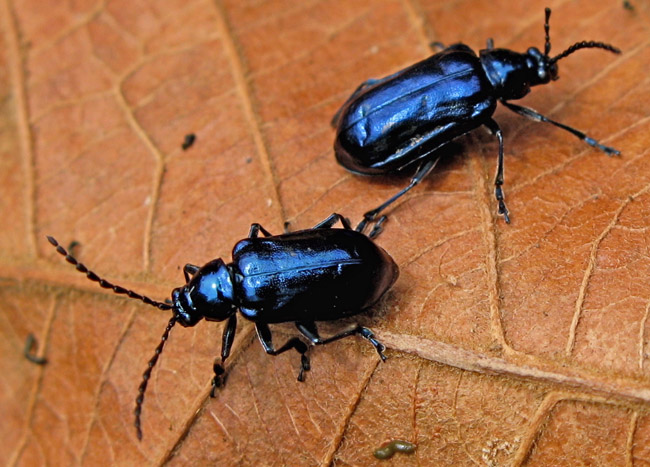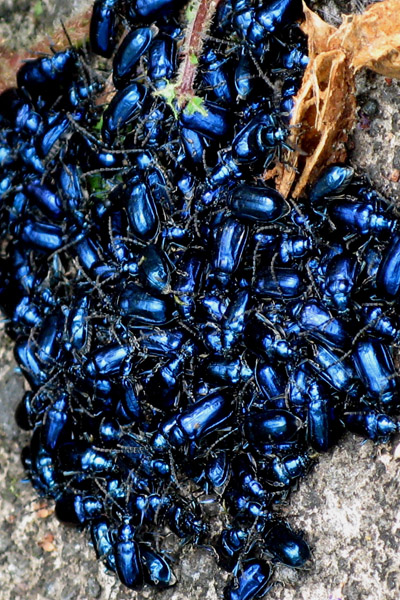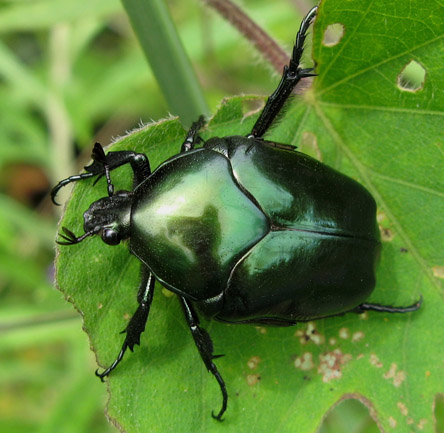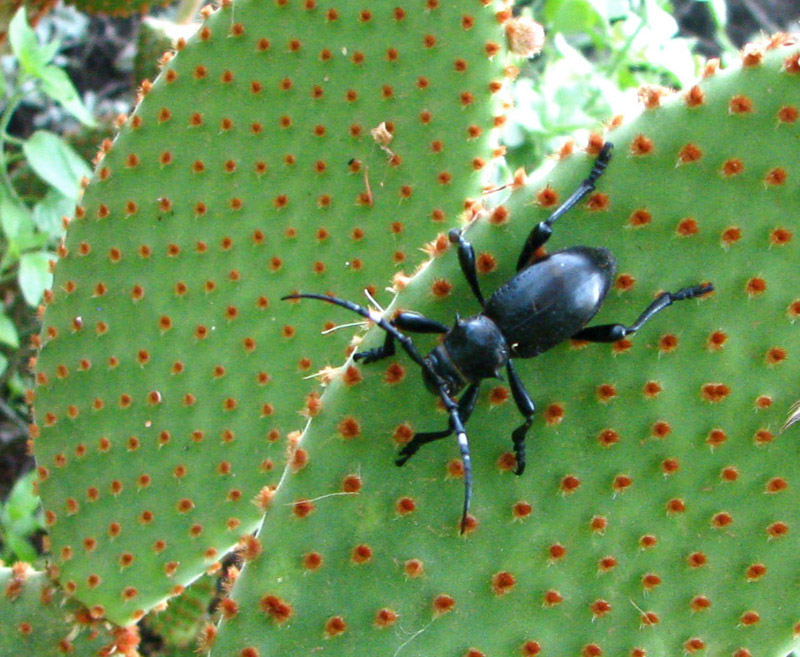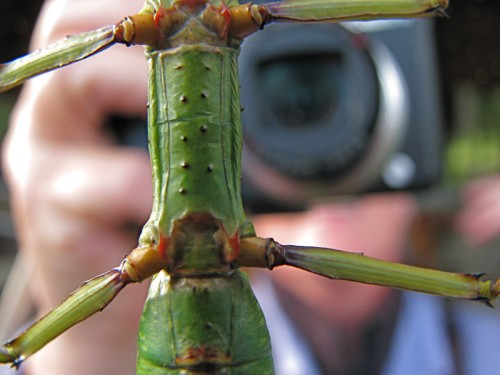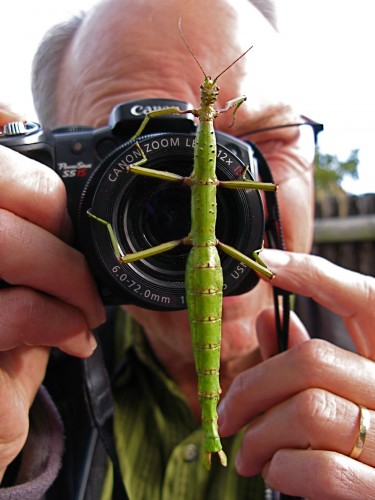 Every once in a while, I find a clay pot — a tiny, perfect clay pot — on the wall of the house. They look like little half-buried Mediterranean amphorae, without handles, with a narrow neck and a flared rim, the entire thing only half an inch across. But they have no openings: like the false-necked vessels drachmai-conscious Athenian families left at the graves of loved ones — they looked full of precious oil while only actually containing a thimbleful — these tiny pots are sealed at the top. Sometimes, however, they have a hole in the side, as if a micro-tomb-robber struck the belly of the pot with a spade, to sift through the contents.
Every once in a while, I find a clay pot — a tiny, perfect clay pot — on the wall of the house. They look like little half-buried Mediterranean amphorae, without handles, with a narrow neck and a flared rim, the entire thing only half an inch across. But they have no openings: like the false-necked vessels drachmai-conscious Athenian families left at the graves of loved ones — they looked full of precious oil while only actually containing a thimbleful — these tiny pots are sealed at the top. Sometimes, however, they have a hole in the side, as if a micro-tomb-robber struck the belly of the pot with a spade, to sift through the contents.
A little spadework in books and on the internet turned up the answer to who the tiny potters in our yard might be : Microdynerus arenicolus, the Antioch Potter Wasp, who builds up this mud cell for its offspring one mouthful of clay at a time.
You would think a wasp bringing mouthful after mouthful of mud to a wall right by the front door might be observed easily, but I’ve never knowingly seen one of these wasps on the job. What I can glean about the appearance and habits of the Antioch Potter Wasp is that they are about half-an-inch long, live in California, southern Arizona and New Mexico, and are solitary wasps. 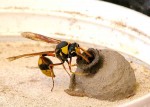 The adults have creamy white or yellow and black markings, and there are subtle differences in coloring and morphology between males and females that are probably mostly important to other wasps and entomologists. (The photo on the left is not our Potter Wasp, it’s a related species from Australia.) The females have stingers, but are “docile”. They are also “domestic”: it’s the female who does all the housework. Here’s what an Arizona Game and Fish document says about the Antioch Potter Wasp:
The adults have creamy white or yellow and black markings, and there are subtle differences in coloring and morphology between males and females that are probably mostly important to other wasps and entomologists. (The photo on the left is not our Potter Wasp, it’s a related species from Australia.) The females have stingers, but are “docile”. They are also “domestic”: it’s the female who does all the housework. Here’s what an Arizona Game and Fish document says about the Antioch Potter Wasp:
These are solitary wasps, each female constructing nests and provisioning them for her own offspring. Each nest looks like a small jug, about half an inch in diameter, with a short sealed neck. When the female decides to make a cell, she selects a sheltered place, and then carries dollops of mud there for construction. This is a precision process with a thin walled pot resulting. When the pot is almost completed, with just room for her to get her head in, she starts to provision the cell with hairless caterpillars, which she has paralyzed by stinging them in the central nervous system. Once the cell is full she lays an egg on the prey and restarts the cell making process. She adds mud to the edges of the nearly spherical pot. Closing the sphere presents problems that are solved by simply adding extra mud and leaving a small neck. The larva that hatches from the egg eats the prey, spins a cocoon inside the pot and pupates. When the new adult is ready to leave the pot, it simply makes a hole in the side and leaves. Using the neck would be logical but that is where the pot is the thickest.
–Arizona Game and Fish Department. 2004. Microdynerus arenicolus. Unpublished abstract compiled and edited by the Heritage Data Management System, Arizona Game and Fish Department, Phoenix, AZ. 4 pp.
Unless you’re a hairless caterpillar, this is a fascinating process. Especially for a potter: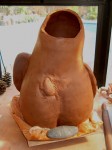 the technique of building a pot from the bottom up, adding little bits of clay at a time, and contouring it as you go is exactly the technique potters use to build vessels or vessel-like sculptures. Vessels of any size and shape can be made as long as the supply of moist clay holds out: the potter wasp makes her own by carrying a mouthful of water to a dry clay source and mixing it up to the right consistency and carrying it to the construction site. To the right is a picture of a Three Star Owl VLO (Very Large Owl) being constructed in the same way as a potter wasp builds her nest. (It will be more than two feet tall and at this point lacked its face. Please note that the finished owl sculpture was not provisioned with hairless caterpillars nor were any eggs at all laid during the process.)
the technique of building a pot from the bottom up, adding little bits of clay at a time, and contouring it as you go is exactly the technique potters use to build vessels or vessel-like sculptures. Vessels of any size and shape can be made as long as the supply of moist clay holds out: the potter wasp makes her own by carrying a mouthful of water to a dry clay source and mixing it up to the right consistency and carrying it to the construction site. To the right is a picture of a Three Star Owl VLO (Very Large Owl) being constructed in the same way as a potter wasp builds her nest. (It will be more than two feet tall and at this point lacked its face. Please note that the finished owl sculpture was not provisioned with hairless caterpillars nor were any eggs at all laid during the process.)
I determined to keep an eye on the little wasp-pot, hoping to see a new wasp break free and fly away, to carry on the work of potter wasps in the yard. Of course, the next time I looked, there was the hole, and the empty belly of the tiny clay amphora — the wasp had flown. Here’s a picture of the hole made from the inside out by the wasp itself, not a grave robber after all: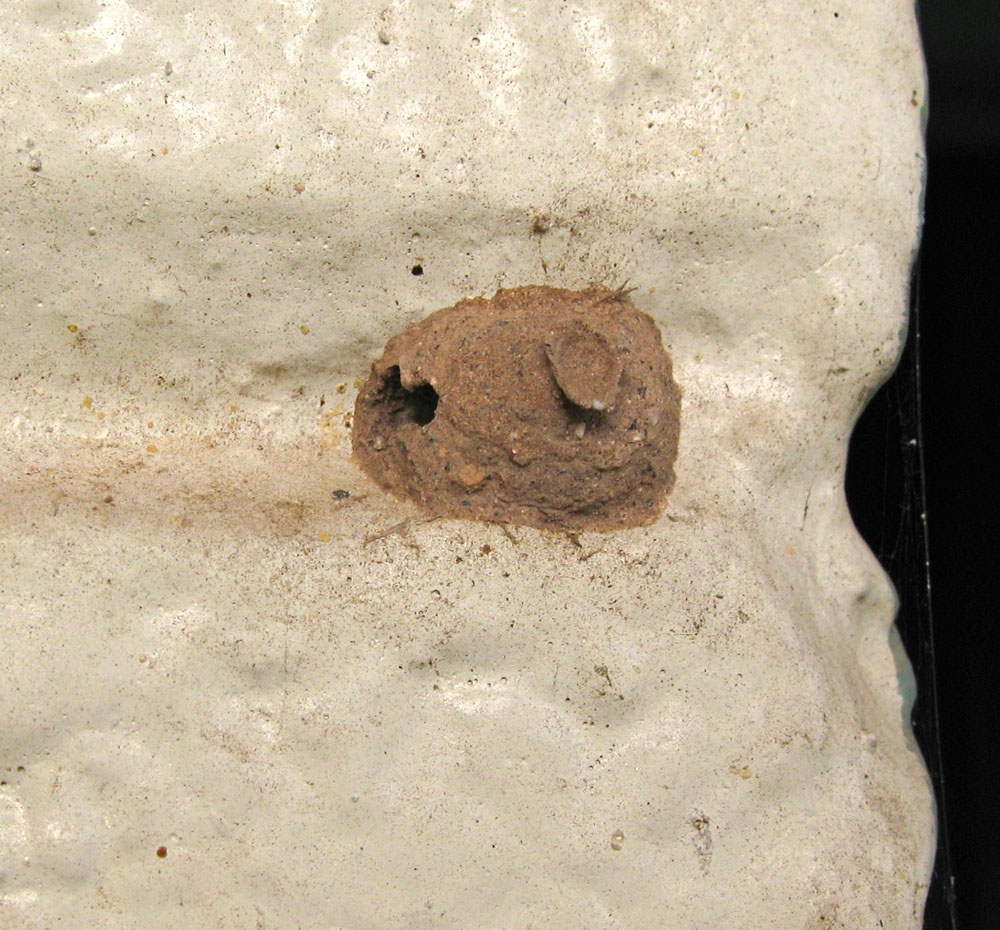
Etymology
The common name, Antioch Potter Wasp, seems like a very appropriately Mediterranean name for an organism that makes structures that look like amphorae, the storage and shipping vessels found all over the Mediterranean region from about the 13th century BC until the 7th century AD. But it’s mere coincidence, and not connected with the ancient city of Antioch on the Levantine coast of the Mediterranean (the stretch of land from which the earliest amphorae, the so-called “Canaanite jars”, come), a hub of commerce and shipping. The species was given its name from the town of Antioch, California, also a hub of commerce and shipping, where the type specimen was collected and described.
(Photos: #1, 3, 4, A.Shock, Three Star Owl. #2, from the following site: http://www.geocities.com/brisbane_wasps/images/MudDau7.jpg, no photo credit found)
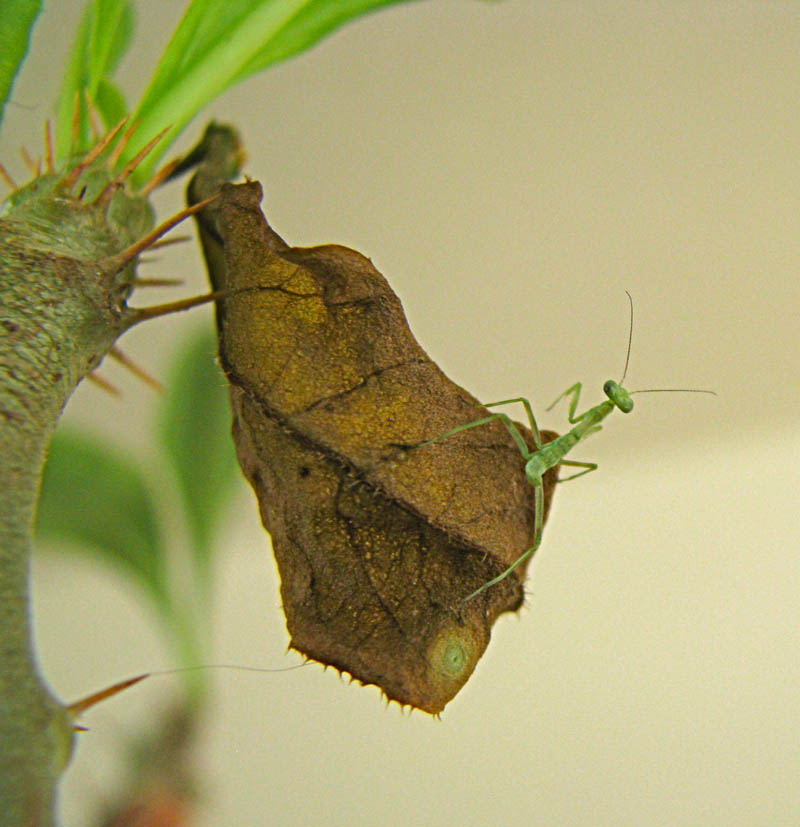 perched in a loft area above the bed. Every once in a while the cats get up there – in the avatar of furry negative forces of destruction and sudden catastrophe – and implement their conviction that one or the other potted plant would be better on the carpet, which results in a loud thump, crushed foliage, and a shower of dirt and gravel onto us in the middle of the night, causing much heart-pounding and swearing.
perched in a loft area above the bed. Every once in a while the cats get up there – in the avatar of furry negative forces of destruction and sudden catastrophe – and implement their conviction that one or the other potted plant would be better on the carpet, which results in a loud thump, crushed foliage, and a shower of dirt and gravel onto us in the middle of the night, causing much heart-pounding and swearing.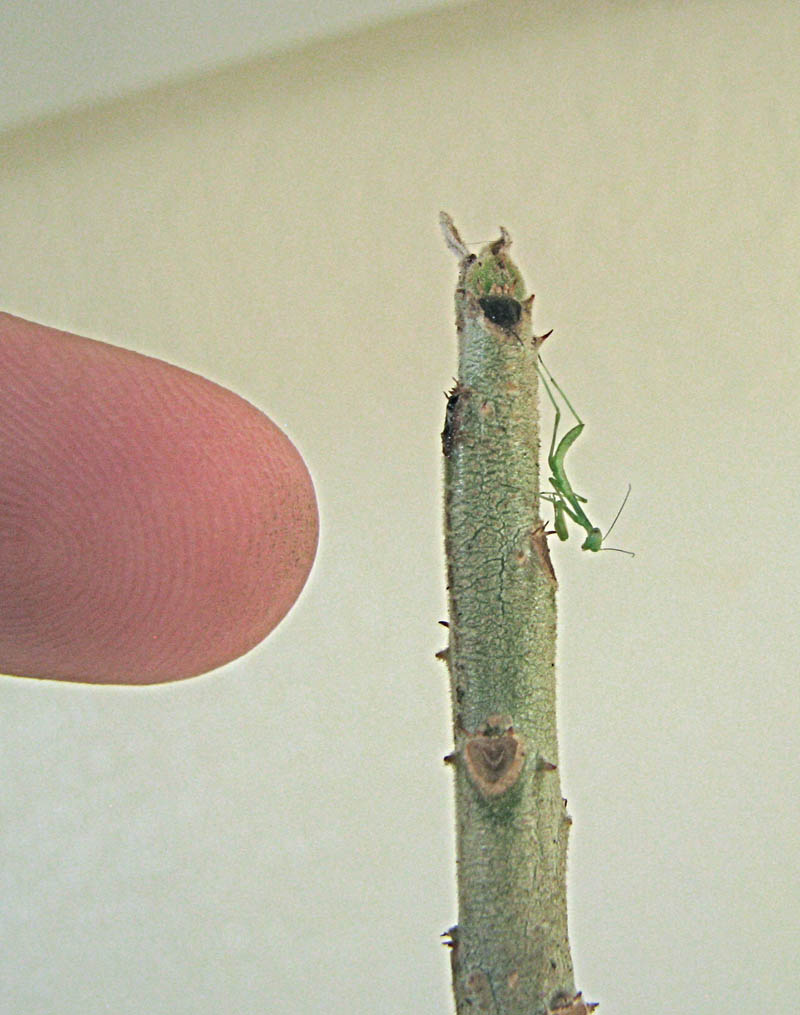 The first we knew about it was when E went up the spiral staircase to water plants, and found, pinnacled on the tip of a succulent, the tiniest possible baby green mantis – looking just like a big one, but not as big as a human fingertip. A quick search around yielded a dozen more, freshly hatched, as well as the egg-case itself on a nearby plant.
The first we knew about it was when E went up the spiral staircase to water plants, and found, pinnacled on the tip of a succulent, the tiniest possible baby green mantis – looking just like a big one, but not as big as a human fingertip. A quick search around yielded a dozen more, freshly hatched, as well as the egg-case itself on a nearby plant.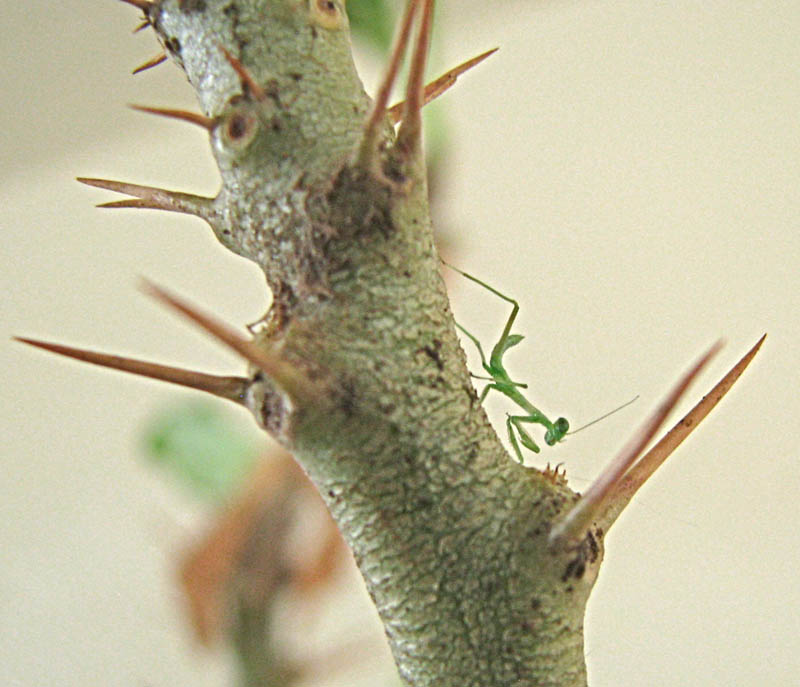 them had made its way away from the eggcase Adenium, except for one guy who figured he was okay where he was. With luck they will mature into one of the mantids native to the Sonoran desert. Or, they may grow into an imported mantid from the Mediterranean or China that people release to control garden pests. Of course, many may be eaten by birds or raccoons, but even that way, they’re in the natural system, and out of the bedroom. Bonne chance, tiny predators!
them had made its way away from the eggcase Adenium, except for one guy who figured he was okay where he was. With luck they will mature into one of the mantids native to the Sonoran desert. Or, they may grow into an imported mantid from the Mediterranean or China that people release to control garden pests. Of course, many may be eaten by birds or raccoons, but even that way, they’re in the natural system, and out of the bedroom. Bonne chance, tiny predators!
